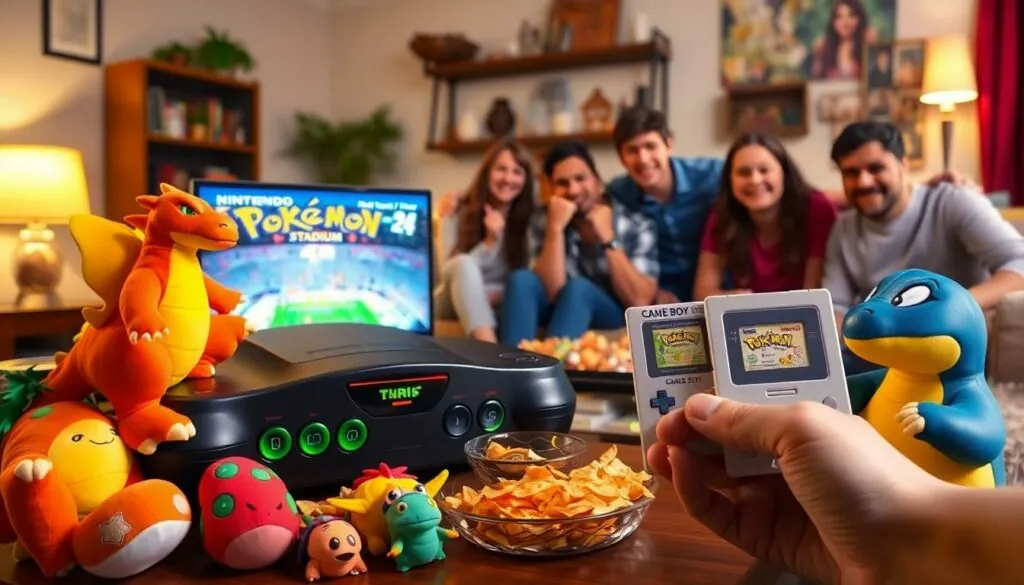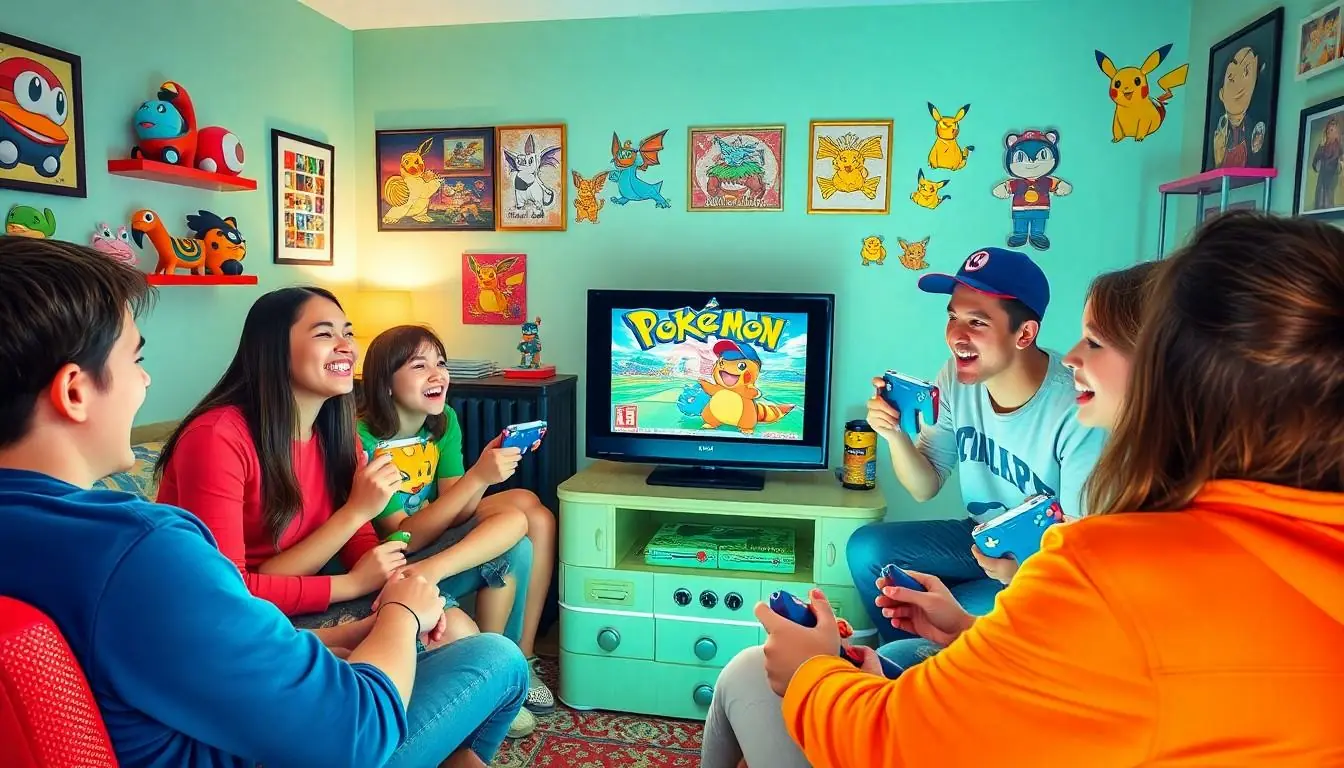Step back into the magical world of the Nintendo 64, where pixels danced and Pokémon ruled the arena. Pokémon Stadium isn’t just a game; it’s a nostalgic trip that had trainers glued to their screens, battling it out with their favorite creatures in vibrant 3D. Forget the real world for a moment—who needs adulting when you can unleash a Charizard to roast your friend’s Blastoise?
Table of Contents
ToggleOverview of Nintendo 64 Pokemon Stadium
Nintendo 64 Pokémon Stadium revolutionized gameplay with its 3D battles, allowing trainers to pit their Pokémon against each other in an arena setting. Released in 1999 in Japan and 2000 in North America, the game introduced players to fully animated Pokémon in a three-dimensional environment. Players utilized their Game Boy cartridges to transfer Pokémon into the Stadium, bringing their teams from Pokémon Red and Blue into the vivid 3D world.
Challenges included various battle modes, such as the Stadium and Gym Leader Cups, offering diverse competition formats. Players could engage in mini-games, enhancing the multiplayer experience and adding layers of excitement. Competitive aspects attracted fans, as they strategized with their favorite Pokémon, experimenting with moves and abilities in real-time.
The game’s graphics stood out, showcasing vibrant colors and detailed character models that captured the essence of the Pokémon series. Sound effects and music complemented the visuals, creating an immersive atmosphere. Stadium battles featured iconic Pokémon like Pikachu and Mewtwo, appealing to both casual and hardcore players.
Compatibility with Pokémon Snap allowed trainers to transfer Pokémon from one game to another, enriching gameplay and fostering a sense of connectivity between releases. This synergy emphasized the popularity of Pokémon as a whole, turning the Nintendo 64 into a hub for Pokémon fans. Players fondly recall the excitement of seeing their Pokémon in 3D battles, solidifying the game’s nostalgic value.
Overall, Nintendo 64 Pokémon Stadium remains a beloved title within the franchise, offering an unforgettable experience for those who seek the thrill of Pokémon battles in a groundbreaking format.
Gameplay Features
Engaging gameplay features define Pokémon Stadium, providing a rich experience for fans of the franchise. Players dive into various modes and enjoy entertaining mini-games, each offering unique challenges.
Battle Modes
Multiple battle modes enhance the competitive experience. Players participate in the Stadium Cup, where battles occur against powerful opponents. Gym Leader Cups challenge trainers to confront iconic leaders from the series, testing strategy and skill. Additionally, the Free Battle mode allows players to create custom matches with friends. Unique battle rules and restrictions create diverse gameplay experiences, ensuring no two battles feel the same. Players can also encounter the Pokémon Laboratory, which allows for Pokémon stats review and experimentation.
Mini-Games
Mini-games add extra fun to the gameplay. Players engage in various challenges, such as “Machop Jump” and “Tetris Puzzle,” designed to test reflexes and timing. These mini-games offer a break from competitive battles, serving as a social hub for friends. Performance in these games can yield rewards, including points or prizes that enhance overall gameplay. Multiplayer options elevate the experience, fostering friendly rivalry among players. Collectively, mini-games contribute to the game’s replay value, keeping players entertained for hours.
Graphics and Sound Design
Pokémon Stadium showcases impressive graphics that transformed the gaming landscape. Detailed character models brought beloved Pokémon to life, allowing them to engage in dynamic battles. The RPG shifted from 2D sprites in earlier games to vibrant 3D arenas, creating a visually stunning environment.
Bright colors and sharp textures enhanced the overall atmosphere, making each battle exciting. Animations played a crucial role, with each Pokémon exhibiting unique movements and attacks. The visual effects, particularly during special moves, created a cinematic feel that captivated players.
Sound design complements the graphics, immersing players in the Pokémon universe. Battle sounds, from the crackle of electric moves to the roar of a fire blast, added depth to gameplay. The background music featured catchy tunes that became iconic, contributing to the nostalgic vibes of the game.
Voice samples of Pokémon during battles added another layer of engagement. Players could hear their favorite characters articulate battle cries, enriching emotional connections. In particular, the sound effects enhanced the thrill of each victory or defeat, making every encounter memorable.
Both visuals and audio worked together to create a cohesive experience. The combination of bright graphics and engaging sound effects meant players enjoyed every moment in Pokémon Stadium. The overall quality set a high standard for future titles within the franchise, establishing a lasting legacy. This combination of groundbreaking graphics and immersive sound design remains a key factor in the game’s enduring popularity.
Nostalgia Factor
Nostalgia encapsulates the essence of Pokémon Stadium for many players. Memories of intense battles with friends, like unleashing a Charizard against a Blastoise, evoke a sense of simpler times. This game transported players into a vibrant 3D world where favorite Pokémon came to life. Those who played remember the thrill of transferring Pokémon from Game Boy cartridges, bridging the gap between handheld adventures and the expansive arena gameplay.
Experiences during multiplayer sessions remain vivid in the minds of longtime fans. Custom matches in Free Battle mode encouraged friends to strategize against each other. Challenging Gym Leaders in the Gym Leader Cups reminded players of their journeys in Pokémon Red and Blue, making every victory feel personal and earned. Mini-games, such as “Machop Jump,” brought laughter and friendly competition, often leading to memorable group moments.
Graphics and sound design elevated nostalgia surrounding Pokémon Stadium as well. Transitioning from 2D to 3D enabled iconic Pokémon models to captivate players. Bright colors and sharp details enhanced every battle, while unique visual effects made each encounter feel cinematic. Voice samples of Pokémon provided a connection that deepened emotional investment. The engaging soundtrack further immersed players in the Pokémon universe, igniting memories associated with each battle.
Ultimately, that combination of stunning visuals, engaging gameplay, and captivating sound continues to resonate. Many players revisit Pokémon Stadium, drawn back to the excitement and joy of those unforgettable experiences. Whether battling friends or exploring the mini-games, nostalgia keeps the spirit of this classic alive.
Competitive Scene
The competitive scene in Pokémon Stadium attracted players eager to test their skills. Many players engaged in intense battles, showcasing their strategic prowess. Events like the Stadium Cup and Gym Leader Cups offered unique challenges, displaying various Pokémon abilities and tactics.
Various battle formats enabled trainers to adapt and refine their strategies. In the Stadium Cup, each contestant faced formidable NPC opponents, demanding quick thinking and adaptability. Stronger teams led to better performances, emphasizing the importance of Pokémon selection. Gym Leader Cups immersed players in nostalgia, allowing them to relive iconic battles against familiar characters from the Pokémon series.
Players often utilized online forums and competitions to connect with others and share strategies. Tournaments showcased the depth of Pokémon gameplay, emphasizing the skillful maneuvering of types and moves. Many competitive players built diverse teams to counter their opponents effectively, fostering a dynamic community.
Competitive play also introduced an array of tactics, from entry hazards to status effects. Trainers learned the value of team synergy, creating combinations that maximized overall effectiveness. Strategic switches during battles became critical, as players adjusted to their opponent’s choices in real-time.
Pokémon Stadium’s competitiveness further strengthened bonds among friends. Players frequently organized local tournaments, creating a lively and engaging atmosphere. These matchups encouraged a healthy spirit of rivalry, with many players striving to improve and dominate their gaming circles.
The vibrant competitive scene remains a significant aspect of Pokémon Stadium’s legacy. Enthusiasts continue to celebrate the game’s role in shaping competitive Pokémon battles, fostering a culture that thrives even years after its release.
Conclusion
Pokémon Stadium stands as a beloved classic that continues to captivate players old and new. Its innovative 3D graphics and engaging gameplay mechanics transformed the Pokémon experience, making battles feel alive and exhilarating. The combination of competitive play and nostalgic charm fosters a lasting connection to the franchise.
Whether it’s the thrill of challenging friends or reliving cherished memories, Pokémon Stadium remains a pivotal part of gaming history. Its impact on the competitive scene and the community surrounding it showcases the game’s enduring legacy. Players will always find joy in revisiting this iconic title, ensuring its place in the hearts of Pokémon fans for years to come.



